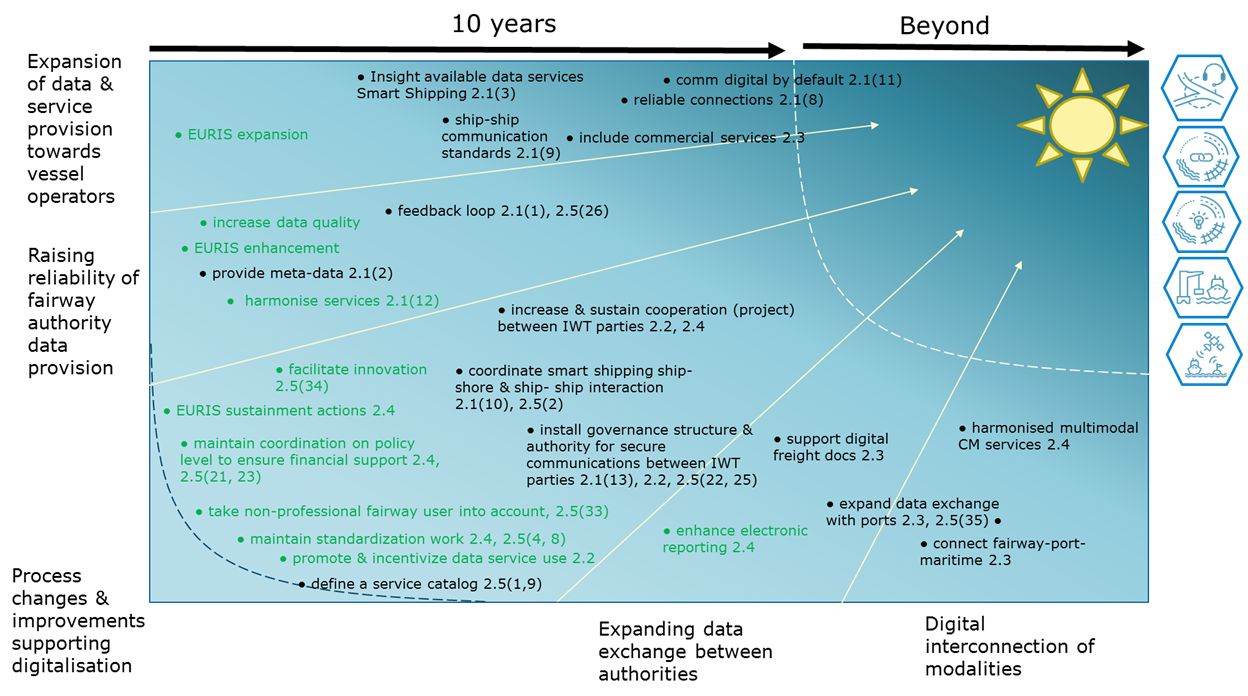The business developments of the Masterplan DIWA project comprise 5 studies. The 5 studies followed a similar approach by describing the current state of digitalization and the foreseen future state in the next decade(s). In the upcoming decade it is envisioned that EuRIS will have established itself as the default digital information platform for IWT with respect to real-time and forecasted fairway-, infrastructure-, traffic and transport information, covering the entire European fairway network relevant for IWT (inland Waterway Transport). Harmonised digital services will have expanded to a service catalogue bringing IWT on a par with the other transport modes and supporting the modal shift towards IWT. Standardised service integration and data exchange with other modalities and logistic service providers will have reduced the administrative burden. Data provided once can be shared digitally with all relevant stakeholders in a secure and GDPR compliant way. Ports will be the digital connection nodes between modalities. Increased safety of navigation is reached by more sophisticated navigational information and the reduction of the administrative burden so vessel operators can focus on sailing. Although fully autonomous vessels are not expected to be a sizeable part of the inland fleet yet in 2032, highly automated vessels with reduced crew and/or remotely operated vessels will be a regular part of the inland waterway traffic.
The main findings for each study are:
- 2.1 Smart Shipping
- Smart shipping is a relatively new business development for IWT. In addition to the required removal of the current legal obstacles, an increased demand for meta data, higher data quality and the need for new communication standards is foreseen.
- 2.2 Synchromodality
-
- The use of synchromodal transport planning and operations by logistics services providers in Europe can be facilitated through a more intensive use of inland waterway data. With the deployment of EuRIS and expansion of the data services most of the needed data services to facilitate this will be in place. Effort is foreseen helping logistics service providers to recognise and use specific data services.
- 2.3 Port & terminal Information services
- A lot of services are already digitised, The inland ports are the central hubs for synchromodal transport. So a strategy needs to be developed how to connect to (inland ports) and port community systems.
- 2.4 RIS enabled corridor management
- The deployment of EuRIS supports the IWT sector. As a next step an improvement of these services is required together with to the stimulation stakeholders to use the new data services. More data services are foreseen that can push corridor management towards network management, electronic reporting and multimodal integration in the next decade.
- 2.5 ITS/ERTMS/e-Navigation
- An in-depth comparison of data services with the other modalities has been made, and the conclusion is that IWT has similar data services on a functional level. 7 data services from other transport modes were found that could be of interest for IWT. The governance of services in other modalities is also interesting for IWT.
The recommendations are plotted in the following figure. The recommendations will be further elaborated in cooperation with stakeholders and within the other activities of the Masterplan DIWA project. In order not to “overload” the picture, some recommended actions have been summarised using a general encompassing term. Where applicable a reference to the sub-activity and action point is mentioned. Items in green signify an ongoing effort across the entire timeline

In general, it can be concluded that the fairway authorities are on track with the digital developments in IWT. Cooperation with stakeholders in the upcoming years to challenge the elaborated (new) data services is key to support the business values. This will lead to the development of new and better services for an IWT service catalogue. A number of recommendations for the roadmap are already identified, that can be categorized by:
- Expansion of data & service provision towards vessel operators and logistic service providers
- Raising reliability of fairway authority data provision
- Expanding data exchange between authorities
- Digital interconnection of modalities
- Process changes & improvements supporting digitalisation
